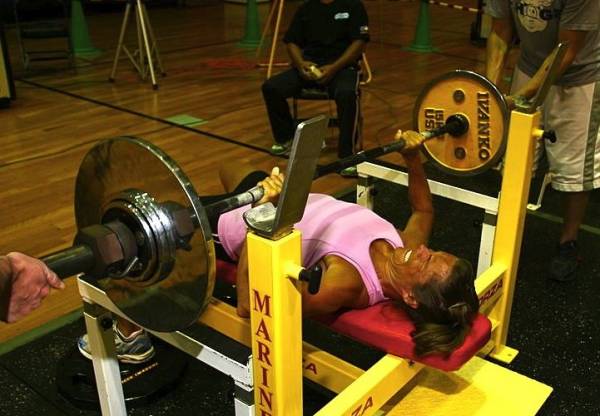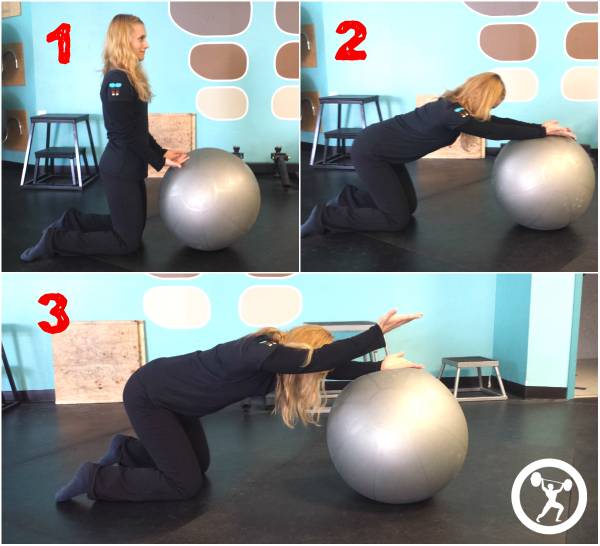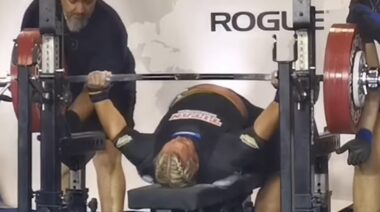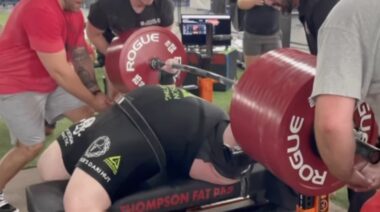The bench press is a staple in the weight room for bodybuilders, athletes, fitness enthusiasts, and powerlifters alike. If you’re reading this, I’m sure you’ve included the bench press into your own fitness routine.
To those of you who bench press, my question is simple: are you really strong enough to be benching? You might be surprised, but for many of you the answer is a resounding “no.”
Related: The Best Chest Workouts for Muscle Mass, Strength, and More
You’re Too Weak to Bench Press
Oh, but you can push 400lb? Good for you! But, that doesn’t mean you should be.
In order to both prevent a nasty shoulder injury and to increase your weight on the bar, you need to have the required shoulder stability and mobility. If you don’t have this, you are putting your shoulders at major risk of injury and stalling your performance gains. Keep benching like this and not only will you have to take a break from the bar, but you will also be in pain and potentially unable to perform your normal daily activities. Not exactly optimal, is it?
Related: The Bench Press Is a Pull: 5 Cues You Might Be Missing
Here’s the deal (and you’ve heard it before): you’re only as strong as your weakest link. When it comes to the bench press, the shoulder stabilizers are almost always the weakest link.
What You Need to Bench Safely
Your scapula (shoulder blade) is the only thing that connects your shoulder to your body. Therefore, the proper functioning of the scapula is crucial when it comes to your overall shoulder health. Furthermore, optimal positioning of the scapula is imperative in order to properly transfer force. What happens if you can’t properly transfer force? Below average lifts and shoulder injuries. In other words, nothing good.
“[Y]ou need to have the required shoulder stability and mobility. If you don’t have this, you are putting your shoulders at major risk of injury and stalling your performance gains.”
Studies have shown that weakness of the scapular stabilizers (and the consequent altered movement and biomechanics) results in increased stress to the shoulder, increased rotator cuff compression, and decreased performance of the shoulder complex. In layman’s terms, this means not only is your scapula not moving properly, but your rotator cuff and shoulder joint function will suffer, in turn affecting your performance and increasing your risk of injury, both traumatic (think tear) and insidious (rotator cuff impingement, tendinosis, etc.).

RELATED: Why Do I Keep Jacking Up My Shoulder? A CrossFitter’s Dilemma
It’s the difference between shooting a cannon from a canoe versus from solid ground. You need a solid, stable base in order to effectively move your limbs. If you don’t have this stable base, two things will happen: your body will have to limit the amount of weight you can stabilize, and it won’t be a question of if you get injured, but when.
How to Test Your Shoulder and Scapular Stability
Here is a simple exercise that acts to both stretch out your upper back (lats) and test your shoulder and scapular stability – the stability ball reach, roll, and lift.
- Start kneeling with your pinky fingers placed gently on the front of the stability ball.
- Roll forward so your arms go into full flexion overhead, externally rotating your shoulders as you roll.
- Your head should be relaxed, and back flat.
- At this point, your shoulders should be fully flexed and your palms facing the ceiling. You should feel a solid stretch in your upper back and shoulders.
- Next, you’re going to lift one hand off of the stability ball, about two or three inches, and hold for three seconds.
- Alternate hands. You should be able to this easily, without any shaking, or pain. In terms of reps, I usually have people do twenty total (ten per side).

If you can do this exercise perfectly then you have my blessing to bench press, as long as you do so with proper form. If you struggle to do this, you better fix it, and fix it quickly before you end up on my table with a shoulder injury.
“A lot of times I have athletes who are incredibly strong come to me with pain or dysfunction. They excel in their sport, can push heavy weight, but can barely do this simple exercise.”
Why Is This a Good Shoulder Test?
This exercise is an excellent indicator of your scapular and shoulder stability. Not only that, but performing it regularly improves mobility of the shoulder girdle as well as trains your scapular and shoulder stabilizers. These stabiliziers include the muscles of your rotator cuff, your serratus anterior, and your lower traps – all key in keeping that cannon on solid ground and far away from the canoe.
RELATED: Why Does the Front of My Shoulder Hurt?
This exercise is actually pretty incredible. A lot of times I have athletes who are incredibly strong come to me with pain or dysfunction. They excel in their sport, can push heavy weight, but can barely do this simple exercise. Their strength hides their dysfunction. This is why this simple test and exercise can serve as a giant wake-up call to them – and to you. I mean, if you bench regularly but can’t lift your hand off of a ball, what does that tell you?
The best part? Once you’ve figured this out, and subsequently work on it, just wait to see your performance, pain, and risk for injury improve.
References:
1. R. Paine and M. Voight, M., “The Role of the Scapula,” International Journal of Sport Physical Therapy, 8 (2013) 617-629.
2. D. Wattanaprakornkul, et al. “Direction-specific recruitment of rotator cuff muscles during bench press and row,” Journal of Electromyography Kinesiology, 21 (2011) 1041-1049.
Photos 1&2 courtesy of public domain, via Wikimedia Commons.






